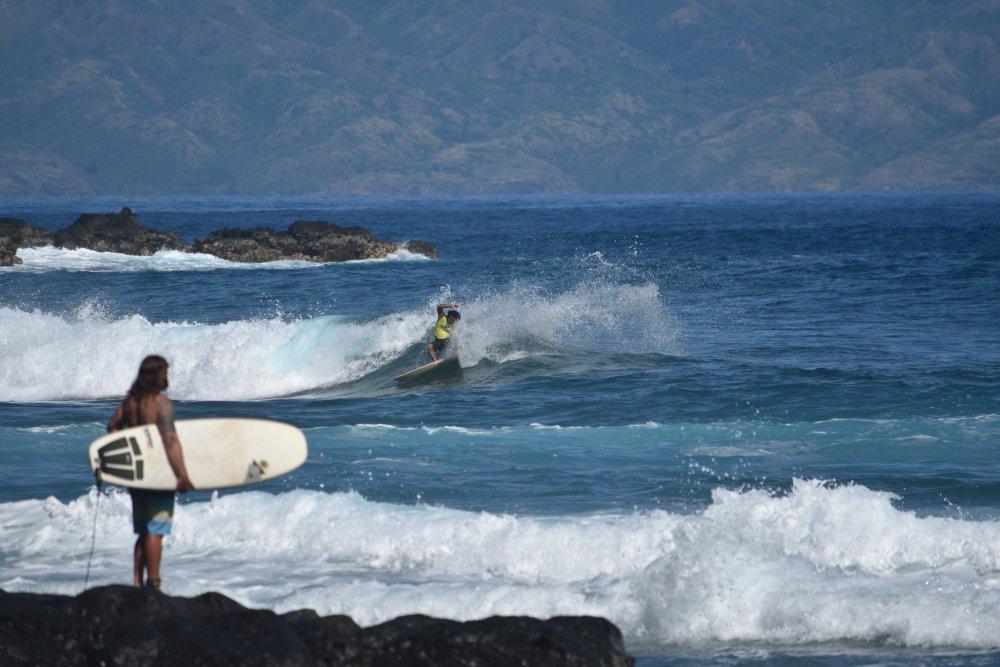Maui’s surf zones challenge intermediate surfers with diverse breaks and shifting currents. From reef encounters to sandy shorelines, careful planning and local insight turn each wave ride into a confident adventure.
Early Start Beats Crowds
Arrive before 7 a.m. to secure parking, catch calmer currents, and access less crowded waves.
Footwear for Rough Terrain
Wear sturdy sandals or water shoes when walking access trails to navigate rocky and uneven terrain safely.
Use Reef-Safe Sunscreen
Protect your skin and local reef ecosystems by choosing environmentally friendly, reef-safe sunscreen.
Hydrate Continuously
Carry insulated water bottles and sip regularly to combat dehydration under the tropical sun.
Mastering Maui’s Surf Zones: Logistics for Intermediate Surfers

Surfari
3 Hour Surfing Tour • For intermediate & advanced surfers
Ready to ride the waves in Maui? Join Action Sports Maui's private Surfari for a personalized surf adventure that caters to all skill levels. Discover hidden surf spots, improve your technique, and soak up stunning coastal views on this exclusive trip.
Maui’s surf zones offer a playground for intermediate surfers ready to step beyond beginner breaks. The island’s varied shorelines present distinct challenges—reef breaks that demand respect, waves that shape and shift with the tides, and currents that push forward with unyielding insistence. Navigating these waters requires not only skill but a clear strategy rooted in local conditions and practical preparation.
Start by targeting surf spots that balance consistent waves with manageable hazards. The iconic Honolua Bay demands respect with its powerful reef and tricky entry, best approached during medium swell when waves settle between 4 to 8 feet. Conversely, Kihei’s gentle, sandy-bottom breaks allow you to focus on refining technique without the nerve-testing bite of coral below.
Access and timing are pivotal. Parking near popular spots like Lahaina or Paia fills quickly by mid-morning, so arrive early—often before 7 a.m.—when the ocean surface still mirrors the dawn and currents are less erratic. Expect to walk 5 to 15 minutes across varied terrains: worn coastal trails morph from dusty paths to rocky ledges, their edges daring you to stay steady. Durable footwear helps here, and carrying your board calls for careful balance and grip.
Hydration and sun protection are non-negotiable. The Hawaiian sun commands respect; lightweight UV-protective clothing and reef-safe sunscreen shield you for hours of exposure. And water bottles—ideally insulated—are your constant companions, as tropical heat and exertion deplete reserves quickly.
Be aware of the undercurrent’s temperament. Maui’s surf zones can be fiercely themselves; currents will test your positioning and paddling stamina. Study daily surf reports and regional forecasts. Apps like Surfline provide live cams and swell predictions to adapt your plan with precision.
Engage with local surfers to get insider knowledge on wave behavior, tide patterns, and hidden swell windows. Respect the ocean’s rhythms and the unwritten rules of Hawaiian surf culture; patience and observation often unlock the best rides.
By combining practical logistics with keen awareness, intermediate surfers unlock the rich, challenging surf zones Maui offers—a dynamic embrace that’s as rewarding as it is demanding.
Nearby Trips
All Adventures
Boat Charters
Water Activities
Adventures near Lahaina
Discover the unique and memorable adventures that make Lahaina special.
Frequently Asked Questions
What intermediate surf spots are safest for reefs?
Kihei and some breaks near Wailea offer sandy bottoms which reduce reef hazards, making them ideal for intermediate surfers still gaining confidence around coral.
How do tidal changes affect Maui’s surf zones?
Tides dramatically alter wave shape and entry difficulty. Lower tides expose more reef, increasing risk, while higher tides soften wave breaks but may intensify currents.
Are there local surf etiquette rules to know?
Respect for priority, avoiding drop-ins, and deferring to more experienced locals maintain harmony. Observing before jumping in helps you understand those unspoken nuances.
Is it necessary to check surf reports daily?
Absolutely. Conditions shift rapidly in Maui, and local surf reports or apps give up-to-the-minute swells, wind, and tide updates crucial for safety and maximizing wave quality.
What wildlife might I encounter while surfing in Maui?
You might spot Hawaiian green sea turtles (honu) lazily cruising or reef fish darting below. Occasionally dolphins appear nearshore, always maintaining a peaceful distance.
Are there alternative access points to crowded beaches?
Yes. Lesser-known entry points exist near Honolua and Launiupoko, often requiring short hikes along rugged coastal trails but offering quieter surf.
Recommended Gear
Medium-Length Surfboard
A board sized to handle variable wave sizes and responsive to reef breaks provides confidence and control.
Reef-Safe Sunscreen
Protect your skin without damaging coral reefs; essential year-round.
Water Shoes or Sturdy Sandals
Necessary for traversing rocky access trails and sharp reef edges at entry points.
Insulated Water Bottle
Keeps water cool through extended surf sessions under strong sun exposure.
Local Insights
Hidden Gems
- "Secret Cove, near Makena offers quieter waves with scenic tide pools at entry"
- "La Perouse Bay features unique lava rock formations framing surf breaks"
Wildlife
- "Hawaiian green sea turtles (honu)"
- "Spinner dolphins"
- "Colorful reef fish"
History
"Maui’s surf culture blends Native Hawaiian traditions with modern surfing, rooted deeply in spiritual respect for the ocean. Some breaks are historic wahi kapu (sacred places) reminding surfers to honor the water’s power."
